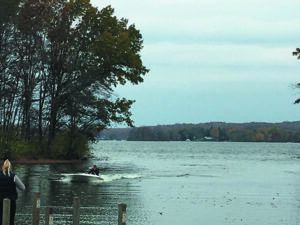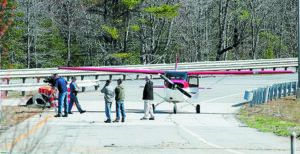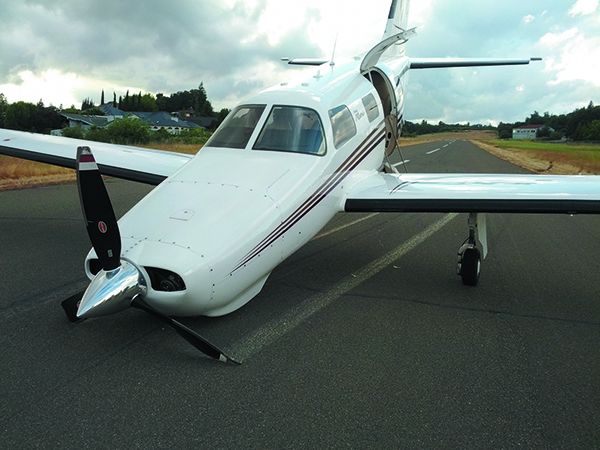Despite our determination to do better, we pilots are human. Frustratingly, because of that we make mistakes. Fortunately, most of those mistakes damage only our self-image as steely-eyed superior beings although from time to time they result in damage to our airplanes.
We’ve been trained to keep an aircraft right side up and on the runway’s straight and narrow and we do a pretty good job. However, we haven’t been trained in what to do in the aftermath of a misstep—the time that while we stayed on the runway’s straight and narrow confines, we did so after forgetting to extend the landing gear.
DON’T PANIC
If the time comes that you damage an airplane and/or you realize that you’ve inadvertently violated one of the FARs, start by realizing that all is not lost. It really isn’t. Take a deep breath, stop everything for a moment and begin acting rather than reacting. We’ll talk about what to do so that you don’t make matters worse.
TRAUMA AND STRESS
You’ve just had a traumatic event. Even if there was no visible damage to anything, your reptile brain is working full time and you are not going to be entirely rational for the next 24 to 72 hours. We’re not kidding. We’ve been there.
Yes, you are a great pilot. You wouldn’t be flying if you didn’t think so. But when something happens that smacks you in the face with the fact that you are not infallible, your ability to talk objectively about what just happened goes down the tubes. Trust us, you can’t self-evaluate—right after the event if someone asks you for directions to the airport, you’ll say “Wichita” and won’t have a clue that you’ve not responded even close to appropriately.
Nevertheless, there are some things that you’re going to have to do right away, and some of those involve telling people that you’ll talk with them later.
First and foremost, if it’s an injury accident, make sure that the injured get medical attention. You’re the PIC: Take charge and get the medics on the way.
After that, do everything you can to stop any sort of steamroller from flattening you. If the airplane is blocking the sole runway and has shut down the airport, don’t agree to having it bulldozed out of the way. If people are trying to hurry you, that’s a huge red flag. Slow down.
ACCIDENT REPORTING
Before you or anyone who shows up out of the woodwork rushes to call the NTSB to comply with NTSB Part 830.5’s immediate accident notification, stop. There is a good chance that the event does not meet Part 830.5’s requirement for immediate notification. If it doesn’t, you are not doing yourself any favors because notification of the NTSB will result in it notifying the FAA and the FAA scrutinizing the event and you.
If you are the only person around that can notify the NTSB and/or law enforcement in a non-injury crash, slow down and make sure that you are required to do so. We suggest that you put the issue aside for an hour or so; you have more important things to do.
SECURE YOUR AIRPLANE
Your next step is to take action to secure the airplane against further damage. Don’t let anyone push you into moving it if there’s any risk that the move will make matters worse. We are reminded of a Cessna Citation I that had a failure in the flap system causing them to suddenly retract—leading to a hard landing.
The airplane wasn’t badly damaged until the airport manager directed that a forklift be used to move the jet. The operator jammed the forks through the pressure vessel in the fuselage, turning a perfectly good airplane into salvage.
In general, you’ll want to get the airplane into a hangar or similar structure where it is out of the rain and can be locked up against the interests of those who wish to acquire avionics at a deep discount.
INSURANCE

Next, get on the phone to your insurance broker—or, if Avemco is your insurer, you don’t have a broker so call the company itself—and report the event. You are not making a claim under your policy at this time, but your policy does require you to notify your insurer of an event within a limited period of time if you do make a claim.
You’ll have time later to decide whether you want to make an insurance claim.
AVIATION LAWYER
Your next call is to your aviation attorney. If you do not have one, contact AOPA’s Pilot Protection Services (www.aopa.org) to get the names of aviation attorneys in your area. If you’re already a plan member some of the cost of your consultation with a plan attorney is already paid. We think it’s an excellent deal and worth the small annual membership fee. If you’re reading this and haven’t yet made a mistake in an airplane this month, we suggest you join the plan now.
Listen to what the attorney tells you. We’ll tell you right now that much of the initial advice is to keep your mouth shut. We know that is hard, as pilots tend to be honest and think that they can “fix” something by applying their huge intellect and talking with someone about it. At this point believe us when we say that there is virtually no chance that you can make things better, and it’s very likely that you can make things worse by running your mouth. So, in general, shut up.
The police will wish to speak with you. Keep it as brief as possible—mostly just say that you’ll speak with them after you’ve had a chance to make sure that you are not injured and have spoken with a lawyer. Keep it polite and keep it short. Anything you say can be twisted and used against you. You can’t talk yourself into a legal jam if you don’t talk.
All of this means that for at least 24 hours after an incident or accident, do not talk more than briefly to an official who is investigating the accident. You are not required to do so right away. Politely get the inspector’s telephone number and arrange to call in the next day or so. Do not call until you have spoken to your attorney.
MEDIA
In a word, don’t. No matter if you slid that gear-up landing to the most beautiful stop in history, don’t talk to the press because you cannot control the story in any fashion. You can easily be made to look like a serial killer barely thwarted in your plan to take out an elementary school with a lethal weapon—your airplane full of fuel. Plus, on the video, you hair will be messed up from your headset and, if you are over 30 and wearing a jumpsuit with patches on it, you’ll look like a clueless dolt.
Don’t return media phone calls or emails. Let it go away—they’ll lose interest soon as they have other stories to cover. Believe us, you cannot save general aviation or inspire others to learn to fly by agreeing to a post-accident media interview. The risk is that you’ll say something that will give the FAA something to latch on to and investigate a low pass gone bad rather than simply concluding that the event was a inadvertent gear-up landing.
FAA AND NTSB
When speaking with either, keep it short and concise and do so only after you’ve spoken to a lawyer. Seemingly innocuous statements have a way of turning into violation actions.
If you are asked to provide a written statement, keep it as brief as possible, then go over it with your lawyer. The bottom line is to make sure that it is 100 percent accurate. Lying to a federal investigator is a felony.
If you know that you made a mistake and busted a reg—and it was honestly a mistake—it may be best that you do talk with the FAA and admit that you made a mistake. We suggest that before doing so that you take dual with a CFI and go over the area of the regs that you inadvertently violated. You want to make sure that you don’t do it again. Plus, that shows your determination to comply with the regs when you speak with the FAA.
Under the terms of the FAA’s Compliance Philosophy, its inspectors seek to counsel pilots regarding inadvertent violations rather than hammer them. The policy has been in force for over five years and, in our observation, it’s a huge success. Speak with your attorney first, but the odds are that the FAA will, at most, spend time talking with you about how the situation might have been avoided and have you take some additional dual with a CFI before it closes the file.
INSURANCE

We are in a “hard” (expensive) insurance market, but we have seen no evidence that aviation insurers are actively looking to find reasons to deny coverage following accidents.
The law on denying coverage in aircraft accidents has been settled for some years. Simplified, if you violate a Federal Aviation Regulation in the midst of having an accident, that violation is almost never grounds for denying insurance coverage. The violation has to be directly related to the cause of the accident and even then it is difficult to deny coverage.
If you have lied about your experience, ratings and/or medical condition on your insurance application, such misstatements are legitimate grounds for an insurer to deny a claim. Never lie or exaggerate on an insurance application.
Bottom line: If you have an accident, your insurer will almost certainly pay under the terms of the policy if you make a claim. Your insurer will also be a resource that can help you in the process of getting the airplane repaired.
INSURANCE DOWNSTREAM
As the market hardened in the last several years we began learning of pilots who could not get their aircraft insurance renewed, or had to pay a great deal to do so. The most common causes were age or an accident history.
We spoke with Kim Skipper of Avemco (www.avemco.com) who told us that when an insured has made a claim the company is going to look at the cause of the accident when it’s time to renew the policy. Frankly, there is some risk that the insurer will not renew the pilot’s policy if the pilot showed bad judgment or poor skills.
That is consistent with what we heard from another broker who did not want his name used. In this market insurers are trying to reduce risks as the cost of repairing airplanes continues to spiral upward, and some underwriters believe that a pilot who had an accident due to questionable skill or judgment is likely to have another.
We did learn from Ms. Skipper that if you do have a claim and your insurer does agree to renew you, stick with that insurer for at least the next few years. Insurers value loyalty. Besides, with an accident history there is an elevated likelihood that it will be hard to find another insurer to cover you.
Skipper told us that Avemco looks back three years for a history of accidents, incidents and claims. We were told by the anonymous broker that other companies look back five years.
During our conversation with Mike Pratt, a broker with Foundation Risk Partners (www.foundationrp.com), he expressed his ongoing frustration with what he called stupid claims, primarily by pilots who had not taken any sort of rigorous recurrent training for we’ll over a year and showed that they couldn’t handle even a moderate crosswind in a tailwheel airplane or decided to go so far below minimums on an instrument approach that they hit something.
It looks to us that the insurance companies are now less willing to insure those who have demonstrated a willingness to perform stupid pilot tricks.
PROTECTING YOURSELF
First and foremost—take frequent recurrent training, especially in crosswind landings as that’s where you are at the highest risk for bending an airplane. We recommend every six months. Once you pass 12 months since your last Flight Review, your accident and/or FAR violation risk starts shooting up.
Join the FAA WINGS program and stay current—experience shows that your risk of an accident or reg violation will drop dramatically.
Enroll in AOPA’s Pilot Protection Program.
More rigorously self-evaluate before and during flight. If you’re a little tired or “just not quite 100 percent” either don’t make the flight or be even more cautious in making full use of checklists, flying a little higher and making more conservative decisions on fuel needed and weather.
Resolve to avoid “hold my beer and watch this” situations. A low pass down a runway is almost always a regulations violation because you aren’t 500 feet from the hangars, parked airplanes and people—and everyone has a cellphone camera.
Finally, don’t do anything dumb.





